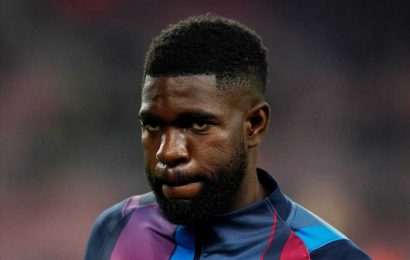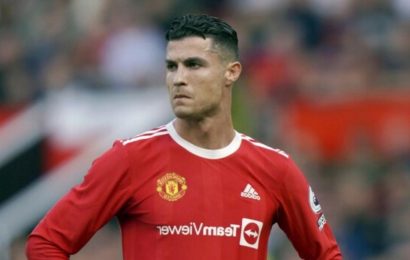PARIS — The contrast could not be more stark.
On a frigid Saturday evening earlier this year inside the Stade Charléty, a World War II-era stadium tucked alongside a highway, the stands are barely a quarter full. Only about 3,000 fans have turned up to watch Paris F.C., a crowd so small that when the home team goes to salute its support after its victory, the players need only to go to one corner of the stadium. The other sections are not even open, given the paltry demand for tickets.
On Sunday, another Paris team takes the field, and fans around the world tune in to watch. This Paris team, the billion-dollar project you know from the Champions League, the one with all the money, all the glamour and all the stars, has traveled to Marseille for another installment of French soccer’s biggest rivalry. There, it takes another step toward its latest championship behind goals from Kylian Mbappé and Lionel Messi.
That yawning gulf between the teams is something that the owners of Paris F.C. are eager to close. They argue that the Paris region, with its population of more than 12 million, deserves an elite league rivalry, the kind that courses through European cities like London and Lisbon, Madrid and Milan.
The problem, Paris F.C. is finding, is that even with soccer’s deepest pool of talent on its doorstep and backing from its own Gulf royals, closing the gap in a one-team town is extremely hard.
Second Team
Sitting in a brasserie close to his home in an upscale neighborhood that houses the tomb of Napoleon, Pierre Ferracci, the majority owner of Paris F.C., is ruminating on why Paris — one of the world’s great cities and the producer of more soccer talent than just about any other metropolis in the world — has only one top-division team, Paris St.-Germain.
Ferracci, 70, lists a group of European capitals before moving on to other large cities to underline the outlier that is Paris. He eventually lands on London, less than a three-hour train ride away, which currently has so many teams playing in the Premier League that Ferracci gives up on naming them all.
He explains away the contrast between France and England (and Germany and Spain and Italy) as a type of French exceptionalism. “It’s cultural,” Ferracci says. “We are less hung up on football than other countries.”
He knows that devotion to the sport, at least in Paris, does not run deep. “The supporters here come when there is success, when we climb the rungs of the ladder,” he said. “They stop coming when the team descends.”
In the stands at the Charléty, the few supporters seem to confirm that view as they offer different motivations for their presence. Zouber Hadj-Larbi, a self-described P.S.G. fan, said he decided to attend his first Paris F.C. game because it was a much cheaper option than a ticket for the team he actually supports.
“It’s also a lot less spectacular,” he said, laughing as the home team struggled to muster a shot on goal. Others in the crowd are tourists; a few say they are taking in the game only because P.S.G. was on the road.
Nearby, Laurent Pinet, part of Paris F.C.’s small cohort of regular fans, commiserated with a friend about the team’s struggles to attract a following. “It’s harder to be a football club in Paris than anywhere else,” he said. “You need immediate results to attract the public.”
Ferracci, who has been the majority owner of the club for 13 years, is confident fans will turn out in greater numbers if the team is playing in the top division, drawn by both its success and its name. “The opportunity we have,” he said, “is that we have a good name: Paris F.C.”
He admits his club is unlikely to ever be a true rival to P.S.G., and definitely not as long as its neighbor is bankrolled by Qatar. But careful and deliberate plans have been laid to build a team that could finally give Parisiens a second top-flight option.
That plan is reliant on tapping a resource Paris has in abundance: talented young soccer players.
Buying Early
Ferracci’s ideas for reviving Paris F.C. crystallized after a dinner with the famed French manager Arsène Wenger a couple years after he took control of the club in 2008. Wenger used hard data, anecdotes and a list of professional players who had grown up in greater Paris to make his point. Ferracci now often does the same.
By his reckoning, 13 percent of all registered soccer players in France are from Paris or its ring of suburbs, and a staggering 50 percent of the professionals making a living in France’s top two divisions grew up in the capital or its shadow. Those players populate not only France’s national team but several others: Morocco. Senegal. Tunisia. Algeria. At last year’s World Cup, for example, Paris F.C. could track seven of its own alumni among the participants.
Just being close to the best players, though, is not enough, said Jean Marc Nobilo. A well-traveled coach, Nobilo was hired two years ago to lead Paris F.C.’s youth development section, and he knows that every big team in Europe now shops for players in Paris.
Ferocious competition for that talent means Paris F.C. is required to unearth it before it has been spotted by others. Bidding wars are typically won by richer teams, thanks in part to French soccer rules that allow clubs to pay fees — sometimes as much as $100,000 — to the parents of gifted children.
For economic reasons alone, Nobilo said, “we must be on the case before the others.”
To ensure that Paris F.C. can do that, Ferracci has enlisted star power and Gulf money of his own. The former arrived in the form of a Paris Saint-Germain legend, the retired Brazilian midfielder Raí, who was hired to be a club ambassador and a connection to soccer’s other great talent basin, São Paulo.
The much-needed money arrived as an investment from the rulers of Bahrain, the Gulf emirate that three years ago became a minority owner in Paris F.C.
Ceding stakes to foreign partners — in addition to the Bahrainis, there are Americans, an Indian group and also Armenian equity owners of Paris F.C. — has been somewhat bittersweet for Ferracci. The cash has helped finance a multimillion-dollar makeover of the club’s training facilities, located on the edge of Paris close to Orly airport, and has helped the club to invest in new talent and the staff to find more of it.
But it has also made Paris F.C. yet another club reliant on foreign capital, a trend that Ferracci laments even as he benefits from it. He says his Gulf royals have been far less munificent than the Emirati owners at Manchester City or the Qataris at P.S.G. — Paris F.C.’s annual revenues of 23 million euros ($25.4 million) are roughly half of what Messi is earning to play across town — and Ferracci is fine with that.
“What I don’t like are countries like the Emirates and Qatar investing in football because it sets the bar too high,” he said, before launching into an unironic soliloquy about how Gulf-funded clubs have destabilized the soccer industry, forcing rivals to risk financial ruin to try and keep up.
Ferracci is determined to maintain control of his team for as long as he can.
“Today I still want the majority of the capital to be in local hands, that the majority stays French and national,” he said. “Why? Because if we continue like this, every club in top two leagues will be in the hands of foreign investors, and I don’t think that’s a good thing.”
For the moment, he is focusing on what his investors, and his plan, have allowed him to pursue: a dream of creating the best finishing school in French soccer. New facilities, the chance to play close to home and the ability to offer teenagers an earlier shot at first-team soccer all give Paris F.C. a fighting chance of meeting its aim of filling at least a third of its roster with homegrown talent. Five players in Paris F.C.’s current squad came through its youth ranks. But it needs even more.
How it handles those recruits and the others that arrive will determine the success of his project. Paris F.C. is currently bumbling through another year in the middle of the second division standings. That means rubbing shoulders with P.S.G., even as a minor irritant rather than a true rival, will have to wait at least another year.
“For now, they are aware of our existence,” said Pinot, one of the team’s regular fans. “We’ll talk about rivalry later.”
Tom Nouvian contributed reporting.
Source: Read Full Article








